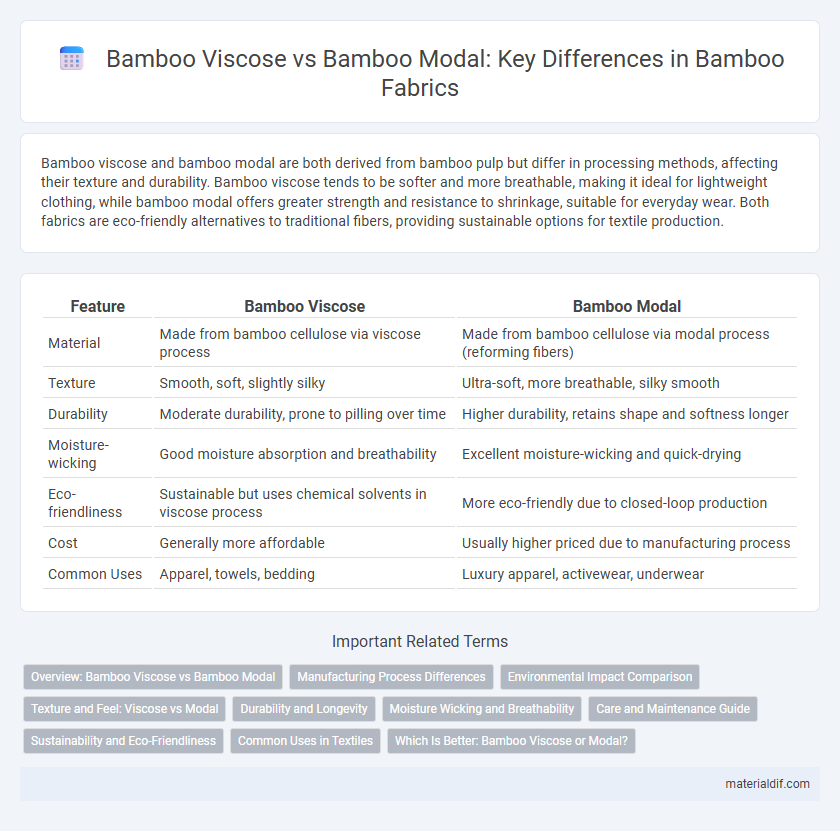Bamboo viscose and bamboo modal are both derived from bamboo pulp but differ in processing methods, affecting their texture and durability. Bamboo viscose tends to be softer and more breathable, making it ideal for lightweight clothing, while bamboo modal offers greater strength and resistance to shrinkage, suitable for everyday wear. Both fabrics are eco-friendly alternatives to traditional fibers, providing sustainable options for textile production.
Table of Comparison
| Feature | Bamboo Viscose | Bamboo Modal |
|---|---|---|
| Material | Made from bamboo cellulose via viscose process | Made from bamboo cellulose via modal process (reforming fibers) |
| Texture | Smooth, soft, slightly silky | Ultra-soft, more breathable, silky smooth |
| Durability | Moderate durability, prone to pilling over time | Higher durability, retains shape and softness longer |
| Moisture-wicking | Good moisture absorption and breathability | Excellent moisture-wicking and quick-drying |
| Eco-friendliness | Sustainable but uses chemical solvents in viscose process | More eco-friendly due to closed-loop production |
| Cost | Generally more affordable | Usually higher priced due to manufacturing process |
| Common Uses | Apparel, towels, bedding | Luxury apparel, activewear, underwear |
Overview: Bamboo Viscose vs Bamboo Modal
Bamboo viscose is produced by chemically processing bamboo fibers into a soft, smooth fabric with moderate durability, commonly used in clothing and bedding for its breathability and moisture-wicking properties. Bamboo modal, a type of rayon made from beech tree pulp but increasingly derived from bamboo, undergoes a more refined process that creates a fabric with greater tensile strength, enhanced softness, and improved resistance to shrinkage and pilling. Both fabrics are eco-friendly alternatives to traditional cotton, yet bamboo modal offers superior longevity and a silkier texture, making it ideal for premium textile applications.
Manufacturing Process Differences
Bamboo viscose is produced by chemically treating bamboo pulp with sodium hydroxide and carbon disulfide to create a viscous solution that is then spun into fibers, resulting in a process similar to traditional rayon production. Bamboo modal involves a more advanced method using cellulose extraction and a closed-loop system that recycles chemicals, making it more environmentally friendly and yielding fibers that are stronger and softer. The key manufacturing difference lies in bamboo modal's use of gentle enzyme treatments and eco-friendlier solvent recovery, enhancing fiber quality and sustainability compared to the more chemically intensive bamboo viscose process.
Environmental Impact Comparison
Bamboo viscose and bamboo modal both originate from bamboo pulp but differ in their environmental impact due to manufacturing processes. Bamboo viscose typically involves heavy chemical use and water pollution, whereas bamboo modal uses a more eco-friendly closed-loop system that recycles chemicals and reduces waste. Choosing bamboo modal over viscose significantly decreases carbon footprint and water contamination, making it a more sustainable textile option.
Texture and Feel: Viscose vs Modal
Bamboo viscose offers a silky, smooth texture with a lightweight feel, making it ideal for breathable clothing and soft bedding. Bamboo modal is known for its consistently softer, more luxurious touch and enhanced durability, often feeling more supple and less prone to shrinkage. Both fabrics excel in moisture-wicking, but modal's superior resilience contributes to a longer-lasting, plush softness over time.
Durability and Longevity
Bamboo viscose and bamboo modal differ significantly in durability and longevity, with bamboo modal offering greater strength and resistance to wear due to its advanced chemical treatment process. Bamboo modal fibers maintain their softness and structural integrity even after multiple washes, making them more suitable for long-lasting clothing and textiles. Bamboo viscose tends to be less durable, as its processing breaks down fibers more extensively, resulting in a fabric that may degrade faster under frequent use.
Moisture Wicking and Breathability
Bamboo viscose and bamboo modal both excel in moisture-wicking and breathability, but bamboo modal offers slightly enhanced performance due to its finer fiber structure, which allows better airflow and faster evaporation of sweat. Bamboo viscose absorbs moisture efficiently, providing a comfortable and dry feel, while bamboo modal's denser fiber network enhances durability without compromising breathability. Choosing bamboo modal can result in more effective temperature regulation and moisture management, ideal for activewear and sensitive skin.
Care and Maintenance Guide
Bamboo viscose requires gentle washing in cold water with mild detergent to prevent fabric weakening and shrinking, while bamboo modal benefits from similar care but is more resistant to pilling and fading. Both fabrics should be air-dried or tumble-dried on low heat to maintain softness and durability. Avoid bleach and fabric softeners to preserve the natural fibers and extend the lifespan of bamboo-based textiles.
Sustainability and Eco-Friendliness
Bamboo viscose and bamboo modal both originate from bamboo fibers but differ in processing methods that impact their sustainability profiles. Bamboo viscose typically involves chemical-heavy processes like carbon disulfide, raising environmental concerns, whereas bamboo modal uses a more eco-friendly solvent spinning method that reduces toxic residues and water consumption. Choosing bamboo modal supports lower carbon emissions and less pollution, aligning better with sustainable textile production goals.
Common Uses in Textiles
Bamboo viscose is widely used in textiles for making breathable, soft fabrics commonly found in activewear, underwear, and bedding due to its moisture-wicking properties. Bamboo modal is favored for high-end clothing, such as lingerie and casual apparel, because of its superior softness, durability, and resistance to shrinkage. Both fibers are popular in sustainable fashion, valued for their eco-friendly production processes and comfort in everyday wear.
Which Is Better: Bamboo Viscose or Modal?
Bamboo viscose and bamboo modal are both sustainable fibers derived from bamboo pulp, but bamboo modal undergoes a more refined chemical process resulting in a softer, more durable fabric with higher moisture-wicking properties. Bamboo modal offers better breathability and resilience compared to bamboo viscose, making it ideal for activewear and luxury bedding. Although bamboo viscose is budget-friendly and biodegradable, bamboo modal's enhanced comfort and longevity often make it the superior choice for eco-conscious consumers seeking high-quality textile performance.
Bamboo viscose vs Bamboo modal Infographic

 materialdif.com
materialdif.com